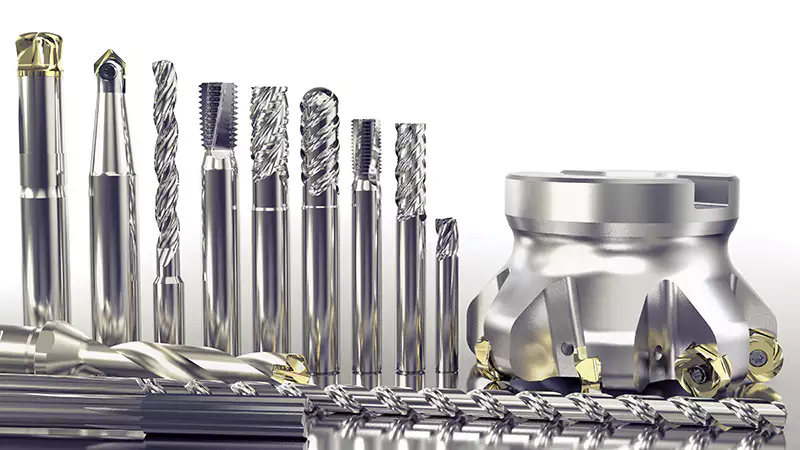Section 1 Type of milling cutter
1. Basic requirements for materials to be cut by milling cutter:
1) high hardness and wear resistance: under normal temperature, some materials must have enough hardness to cut into the workpiece;With high wear resistance, the tool will not wear and prolong the service life.
2) good heat resistance: the tool will produce a lot of heat in the cutting process, especially when the cutting speed is high, the temperature will be very high, therefore, the tool material should have good heat resistance, not only can maintain high hardness at high temperature, but also can continue to cut. This kind of high-temperature hardness property is also called thermal hardness or red hardness.
3) high strength and good toughness: in the cutting process, the cutting tool must bear a great impact force, so the tool material should have a high strength, otherwise it is easy to fracture and damage.Because the milling cutter will be impacted and vibrated, the milling cutter material should also have good toughness, so that it is not easy to break the edge.
2. Common materials of milling cutter:
(1) high speed tool steel (referred to as HSS, front steel, etc.) is divided into general and special purpose high speed steel.It has the following characteristics:
A. the content of alloy elements W, Cr, Mo and V is high, and the quenching hardness can reach hrc62-70.At 6000c, the hardness is still high.
B. the edge strength and toughness are good, and the vibration resistance is strong. It can be used to manufacture tools with general cutting speed. For machine tools with poor rigidity, high-speed steel milling cutter can still be used to cut smoothly.
C. good process performance, easy forging, machining and grinding. It can also manufacture tools with complex shapes.
D. compared with cemented carbide materials, it still has low hardness, poor red hardness and wear resistance.
(2) cemented carbide: it is made of metal carbide, tungsten carbide, titanium carbide and cobalt based metal binder by powder metallurgy process.Its main characteristics are as follows:
It can withstand high temperature and maintain good cutting performance at 800-10000 C. the cutting speed can be 4-8 times higher than that of high-speed steel.High hardness and good wear resistance at room temperature.Low bending strength, poor impact toughness, the blade is not easy to grind very sharp.
Commonly used cemented carbide can be divided into three categories
(1) tungsten cobalt cemented carbide (YG)
The more GY3 and the more cobalt content, the better the impact resistance.Therefore, the alloy is suitable for cutting cast iron and non-ferrous metals, and can also be used for cutting roughcast with high impact, quenched steel and stainless steel parts.
(2) titanium cobalt cemented carbide (YT)
The common brands are YT5, YT15 and yt30, and the number indicates the percentage of titanium carbide.The cemented carbide containing titanium carbide can increase the bonding temperature of steel, reduce the friction coefficient, and slightly improve the hardness and wear resistance, but reduce the bending strength and toughness, making the properties brittle. Therefore, this kind of alloy is suitable for cutting steel parts.
③ General purpose cemented carbide
(3) General purpose cemented carbide
Adding proper amount of rare metal carbides, such as tantalum carbide and niobium carbide, into the two kinds of cemented carbides can refine the grains, improve the hardness at room temperature and high temperature, wear resistance, bonding temperature and oxidation resistance, and increase the toughness of the alloys. Therefore, this kind of cemented carbide tool has better comprehensive cutting performance and versatility, and its grades are yw1, yw2 and ya6,Because of its high price, it is mainly used for difficult to machine materials, such as high strength steel, heat-resistant steel, stainless steel, etc.
Section 2 types and marks of milling cutters
1.According to the material of the cutting part of the milling cutter:
A. high speed steel milling cutter: it is used for more complicated cutting tools
B. cemented carbide milling cutter: it is mostly welded or mechanically clamped on the cutter body
2.According to the use of milling cutter:
A. milling cutter for machining plane: cylindrical milling cutter, end milling cutter, etc
B. milling cutter for machining groove (or stage): end mills, disc milling cutter, saw blade milling cutter, etc
C. milling cutter for special surface: forming milling cutter, etc
3.According to the structure of milling cutter:
a. Sharp tooth milling cutter: the profile of tooth back is straight line or broken line. It is easy to manufacture and sharpen, and the edge is sharp.
b. Relief milling cutter: the profile of the tooth back is an Archimedean spiral line. After grinding, as long as the front angle remains unchanged, the tooth profile remains unchanged, so it is suitable for forming milling cutter.
The marking of the milling cutter (the material is generally W18Cr4V) Size specification marking: cylindrical milling cutter, three-sided blade, saw blade milling cutter, etc. outer diameter X width X inner hole (X angle or arc radius), end mills and keyway milling cutters are generally Only the outer diameter is marked.
Section 3 The main geometric parameters and functions of milling cutter
1. Name of each part of milling cutter
Base plane: the plane passing through any point on the cutting tool and perpendicular to the cutting speed of the point
(2) cutting plane: the plane passing through the cutting edge and perpendicular to the base plane
(3) rake face: the plane where the chip flows out
(4) flank: the face opposite to the machined surface
2. Main geometric angles and functions of cylindrical milling cutter
(1) anterior angleγ0: included angle between rake face and base surface.The function is to make the cutting edge sharp, reduce the metal deformation during cutting, and the chip is easy to discharge, so that the cutting force is saved;
(2) posterior angleα0: included angle between flank and cutting plane.Its main function is to reduce the friction between the flank and the cutting plane and reduce the surface roughness of the workpiece;
(3) rotation angle 0: the included angle between the tangent line on the edge of spiral tooth and the axis of milling cutter.The function is to make the cutter teeth gradually cut into and cut off the workpiece, and improve the cutting stability.At the same time, for cylindrical milling cutter, the chip can flow out smoothly from the end face
3. Main geometric angles and functions of end mills
The end milling cutter has one more auxiliary cutting edge, so in addition to the front angle and rear angle, there are:
(1) main deflection angle Kr: the angle between the main cutting edge and the machined surface.The change affects the length of the main cutting edge and the width and thickness of the chip
(2) secondary deflection angle KRˊ:The angle between the secondary cutting edge and the machined surface.The function is to reduce the friction between the secondary cutting edge and the machined surface, and affect the polishing effect of the auxiliary cutting edge on the machined surface
(3) blade angleλs: The angle between the main cutting edge and the base surface.It mainly plays the role of oblique cutting edge
Section 4 form milling cutter
The shape milling cutter is a special milling cutter used to process the formed surface. Its blade profile needs to be designed and calculated according to the profile of the workpiece to be processed. It can process the surface with complex shape on the general milling machine. It can ensure that the shape is basically consistent and the efficiency is high. It is widely used in mass production and mass production.
1. Basic concept of relief tooth: form milling cutter can be divided into sharp tooth and relief tooth
It is difficult to manufacture and sharpen the sharp tooth form milling cutter because it needs special profiling.
The tooth back of relief form milling cutter is formed by relieving and grinding on the relief lathe. When regrinding, only the front face is ground. Because the front face is flat, it is convenient to grind. At present, the structure of relief tooth back is mainly used in form milling cutter.Two conditions should be satisfied: 1) the shape of cutting edge remains unchanged after regrinding; 2) obtain the required back angle.
2. Tooth back curve and equation: the end section perpendicular to the axis of the milling cutter is made through any point on the cutting edge of the milling cutter, and the intersection line between it and the surface of the tooth back is called the tooth back curve of the milling cutter.
The tooth back curve should satisfy two conditions: first, the back angle of the milling cutter after each regrinding is basically unchanged;The other is simple manufacturing.
Only logarithmic helix can meet the requirement of constant back angle, but it is difficult to make.After the helix is made, the Archimedes angle can be easily realized.Therefore, Archimedes spiral is widely used as the tooth back curve of form milling cutter in production.
From the geometry knowledge, the vector radius of each point on the Archimedes helix ρ Value, the rotation angle with the radius of the vector θ Increase or decrease the value in equal proportion
Therefore, the Archimedean spiral can be obtained by combining the constant speed rotation motion with the constant speed linear motion along the radius direction.
In polar coordinates: when θ=At 00:00,ρ=R. (R is the radius of milling cutter), when θ>At 00:00,ρ<r,< p=””></r,<>
The general equation of tooth back of milling cutter is as follows:ρ=R-CQ
Assuming that the blade does not retract, the milling cutter rotates every one tooth angle ε=2 π / Z, the amount of shovel teeth is k, corresponding to this, the increase of cam should also be K.In order to make the blade move at the same speed, the curve on the cam should be Archimedean spiral, so it is easy to make.In addition, the cam size only depends on the shovel sales K value, and has nothing to do with the cutter diameter, tooth number and back angle.The cam can be used as long as the production and sales are equal.This is also the reason why Archimedes spiral is widely used in the tooth back of relief form milling cutter.
When R: R is known, the cutter radius can be obtained
When θ=2 π/z ρ=R-K
Then R-K=R-2πC /z ∴ C= Kz/2π
Section 5 What will appear after milling cutter passivation
1. From the chip shape, the chip becomes thick and flaky. As the chip temperature increases, the chip color becomes purple and smoke.
2. The surface roughness of the workpiece is very poor, and there are bright spots on the surface of the workpiece, with gnawing marks or ripples.
3. The milling process produces serious vibration and abnormal noise.
4. From the blade shape, there are bright white spots on the blade.
5. When the carbide milling cutter is used to mill steel parts, a lot of fire mist often flies out.
6. When milling steel parts with high-speed steel milling cutter, a large amount of smoke will be produced if oil is used for lubrication and cooling.
When the milling cutter is passivated, it should be stopped in time to check the wear of the milling cutter. If the wear is slight, the cutting edge can be polished with a whetstone and then reused;If the wear is heavy, grinding must be carried out to prevent excessive wear of the milling cutter.



